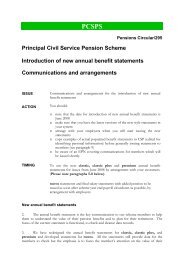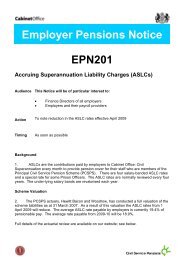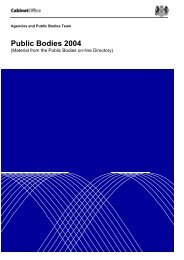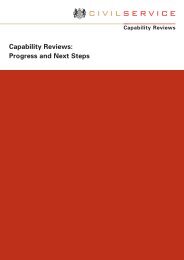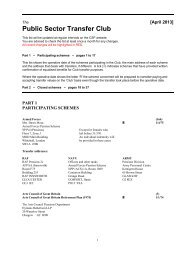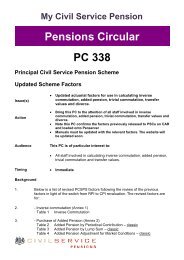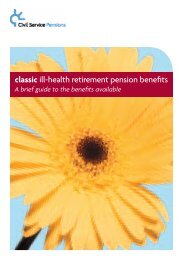'Lessons from Theory for Practice' Summary of ... - The Civil Service
'Lessons from Theory for Practice' Summary of ... - The Civil Service
'Lessons from Theory for Practice' Summary of ... - The Civil Service
- No tags were found...
You also want an ePaper? Increase the reach of your titles
YUMPU automatically turns print PDFs into web optimized ePapers that Google loves.
Background• Responding to the rise <strong>of</strong> the behaviour change agenda• Cross-govt review commissioned by GSR (HMT, MoJ, DfT, Defra, DWP,CLG, FSA, WAG, TSG)Objectives• Overall, to make sense <strong>of</strong> models <strong>of</strong> behaviour change, <strong>for</strong> researchanalysts and policy makers- Provide overview <strong>of</strong> relevant models and theories- Provide guidance on their uses and limitsMethodology• Desk research, plus audience ‘Needs Analysis’- Interviews with 11 departmental analysts- Data gathering via 18 experts- Review based on 109 sources- Peer reviews, and comments <strong>from</strong> analysts, economists, policymakers...
Key Findings• A distinction made between behavioural models and theories <strong>of</strong> change- Behavioural models identify the factors influencing behaviour- <strong>The</strong>ories <strong>of</strong> change show how behaviours change, and can be changed• A fine distinction: easier to observe in practical guidance than inconceptual classification• Understanding both bodies <strong>of</strong> theory essential <strong>for</strong> developing effectiveinterventions• As a result, practical Framework <strong>for</strong> Model-Based Interventions proposed,as Nine Principles• Framework embeds behavioural models within a development processshaped by theories <strong>of</strong> change
Review <strong>of</strong> <strong><strong>The</strong>ory</strong>: Behavioural Models1. Underlying Assumptions• Economic theory the starting point <strong>for</strong> understanding behaviour- Rational Choice theory, and utility maximisation- Preferences are ‘<strong>of</strong>f the model’ (assumed constant)• Economists note idiosyncratic decision making: ‘bounded rationality’• Heuristics included in principles <strong>of</strong> ‘behavioural economics’, mergingeconomic and psychological understandings• In psychology, rational choice as linear ‘Expected Utility’ models; alsoas (In<strong>for</strong>mation) Deficit models
Review <strong>of</strong> <strong><strong>The</strong>ory</strong>: Behavioural Models2. Social-Psychological Factors• Social-psychological models the standard <strong>for</strong> behaviour change• From Expectancy Value <strong><strong>The</strong>ory</strong> (based in attitudes), becomingincreasingly Adjusted (EV models), ie. less deliberative• Factors inc.- Values, beliefs, attitudes- Norms- Agency- Habit- Affect
Figure 1: Ajzen’s <strong><strong>The</strong>ory</strong> <strong>of</strong> Planned Behaviour (1986)Beliefs aboutoutcomesEvaluation <strong>of</strong>outcomesAttitudetowards thebehaviourRelative importance<strong>of</strong> attitude andnormIntentionBehaviourBeliefs aboutwhat othersthinkSubjectivenormPerceivedBehavioural Control
Figure 2: Triandis’ <strong><strong>The</strong>ory</strong> <strong>of</strong> Interpersonal Behaviour (1977)Beliefs aboutoutcomesEvaluation <strong>of</strong>outcomesNormsAttitudeFacilitatingConditionsRolesSocial factorsIntentionSelf-conceptEmotionsAffectBehaviourFrequency <strong>of</strong>past behaviourHabits
Review <strong>of</strong> <strong><strong>The</strong>ory</strong>: Behavioural Models3. External Factors• External factors <strong>of</strong>ten left ‘<strong>of</strong>f the model’• Where ‘facilitating conditions’ are featured, also include individual’sresources (skills and abilities)• But (unmapped) external/material factors act as barriers to change• Models at higher level <strong>of</strong> scale also required, eg Main Determinants <strong>of</strong>Health, NOA• Individual processes (biological/cognitive) influenced by societal factors
Figure 3: Vlek et al’s NOA Model (1997)Technology Economy Demography Institutions CultureNeedsRelations, development, com<strong>for</strong>t, pleasure, work,health, privacy, money, status, safety, nature,freedom, leisure time, justiceOpportunitiesAvailability,advertisement, prices,shopsAbilitiesFinancial, temporal,spatial, cognitive,physicalMotivationBehavioural controlIntentionConsumer behaviourSubjective well-being, environmental quality
Review <strong>of</strong> <strong><strong>The</strong>ory</strong>: <strong>The</strong>ories <strong>of</strong> Change1. Change <strong><strong>The</strong>ory</strong>• Less consensus around literature on theories <strong>of</strong> change: <strong>of</strong>ten practicalnot conceptual in purpose• eg. Lewin’s Change <strong><strong>The</strong>ory</strong> (1947) on changing habits• Based on unfreezing/refreezing dynamic, lifting habits up to consciousscrutiny• Habits as positive ‘resistance to change’ based on group standards• ‘Group decision’ is vital; better than ‘a good lecture’• Lewin as the father <strong>of</strong> action research (learning through doing)“<strong>The</strong>re is nothing so practical as good theory”
Review <strong>of</strong> <strong><strong>The</strong>ory</strong>: <strong>The</strong>ories <strong>of</strong> Change2. Change as a ProcessProchaska & Di Clemente’s Transtheoretical (‘Stages <strong>of</strong> Change’) Model (1983)• Changing habits as progress through 6 segments• 10 stage-matched interventions (‘processes <strong>of</strong> change’)• Developed <strong>from</strong> smoking cessation, but increasingly rejected bypractitionersRogers’ Diffusion <strong>of</strong> Innovations (1962-)• Explains adoption <strong>of</strong> innovations through society, based on S-curve• Segments public into five types (‘innovators’ to ‘laggards’) who adopt basedon a five step ‘In<strong>for</strong>mation-Decision Process’• Developed to model take-up <strong>of</strong> technologies, not the spread <strong>of</strong> behaviours⇒Value predominantly conceptual: behaviour as a process not an event
Review <strong>of</strong> <strong><strong>The</strong>ory</strong>: <strong>The</strong>ories <strong>of</strong> Change3. Change as Learning• Formal learning a key tool in behaviour change interventions- In<strong>for</strong>mation-Motivation-Behavioural Skills Model (IMB)- Education <strong>for</strong> Sustainable Development (eg ESD1 / ESD2)• Learning theory has learning and change as intertwined- eg Deweyan Inquiry (learning as surprise)• Double loop learning distinguishes between ‘instrumental’ and ‘process’learning (action and reflection)• Second loop learning necessary <strong>for</strong> trans<strong>for</strong>mational change• Reshapes ‘underlying assumptions’ (Schein)“Learning and change cannot be imposed on people”
Figure 4: Argyris and Schon’s Double Loop Learning (1978)Consequences andother changesActingNew mentalmodelDiscoveringChoosingPreviousmental model
Review <strong>of</strong> <strong><strong>The</strong>ory</strong>: <strong>The</strong>ories <strong>of</strong> Change4. Change in Systems• Systems defined by their ‘emergent properties’, which provide theirresistance to change• In human activity, ‘emergent properties’ account <strong>for</strong> ‘policy resistance’• Systems thinking as “a discipline <strong>for</strong> seeing wholes”• Thus a diagnostic (not practical) technique <strong>for</strong> approaching complexproblems, or ‘messes’• Produces diagrams and maps, not models
Figure 5: Foresight’s Obesity System Map (2007)
Practical Guidance: A Model-Based Framework‘Nine Principles <strong>for</strong> designing and developing interventions based on models’1. Identify the audience groups and target behaviour2. Identify relevant behavioural models3. Select the key influencing factors4. Identify effective intervention techniques5. Engage the target audience as ‘actors’6. Develop a prototype intervention7. Pilot the intervention, and monitor8. Evaluate: adapt, extend or abandon9. Gather learnings and feed back in
Practical Guidance: A Model-Based Framework‘Nine Principles <strong>for</strong> designing and developing interventions based on models’1. Identify the audience groups and target behaviourBehaviouralModelsHere2. Identify relevant behavioural models3. Select the key influencing factors4. Identify effective intervention techniques5. Engage the target audience as ‘actors’6. Develop a prototype intervention7. Pilot the intervention, and monitor8. Evaluate: adapt, extend or abandon9. Gather learnings and feed back in
Practical Guidance: A Model-Based Framework‘Nine Principles <strong>for</strong> designing and developing interventions based on models’1. Identify the audience groups and target behaviourBehaviouralModelsHere2. Identify relevant behavioural models3. Select the key influencing factors4. Identify effective intervention techniques5. Engage the target audience as ‘actors’6. Develop a prototype intervention7. Pilot the intervention, and monitor8. Evaluate: adapt, extend or abandon9. Gather learnings and feed back in<strong>The</strong>ories <strong>of</strong>ChangeHere
Practical Guidance: A Model-Based FrameworkPrinciple 2: Selecting Models• Models assessed in terms <strong>of</strong> their predictive capacity (based on factors)• Endpoint is a shortlist <strong>of</strong> influencing factors, not a ‘winning’ model• Key factors go on to draft strategy as intervention obejctives• A dual-path method:Path 1 = From Models to FactorsPath 2 = From Research Data to Models and Factors1.Behavioural Models2.Research DataInfluencing Factors
Practical Guidance: A Model-Based FrameworkPrinciple 2: Selecting Models• Guidance includes two tables as starting points <strong>for</strong> model selection- Table 1 matches behavioural models (and factors) to behaviours- Table 2 matches behavioural models to types <strong>of</strong> behaviour• Use both together, or just Table 2 if no match in Table 1eg ‘Seatbelt Use’ as TPB, social norms and habit (in Table 1)...as a ‘habitual’ behaviour could also be TIB (in Table 2)• Note: multiple matches to models and factors possible• Note: weight <strong>of</strong> influence not quantified⇒ Further interrogation required (using dual-path method above)
Practical Guidance: A Model-Based FrameworkPrinciple 4: Identifying Intervention Techniques• Once objectives have been set, identify intervention techniques toaddress those key factors- From process-based models <strong>of</strong> change (eg. Stages <strong>of</strong> Change, IMB)- From case studies <strong>of</strong> past practice- From meta-analyses(eg. Abraham and Michie 2007, matching BCI elements to models)• Work up prototype intervention through collaboration with audience asactors• Solutions must be flexible to audience groups, and behaviour-specific• GSR Project 2 to provide further guidance...
Practical Guidance: A Model-Based Framework<strong>The</strong> Role <strong>of</strong> ResearchUnderstandbehaviour/audienceFeedoutcome/processlearnings back inInterrogate models/identify key factorsEvaluate pilot/final interventionAgree objectives/success measuresPilot and monitorInterrogate evidenceon interventionsDevelopprototypewith ‘actors’
Example <strong>from</strong> Practice: FRANK (2005-06)• FRANK’s Objective:“to prevent or delay the onset or escalation <strong>of</strong> drug use” among 11 to 18 year olds• One sub-audience: non-users at risk <strong>of</strong> becoming users (11 to 14s)• From desk research, Gibbons and Gerrard’s Prototype/Willingness Model(2003) <strong>of</strong> risky behaviours identified <strong>for</strong> drug trying and early using• ‘Risk images’ identified in campaign strategy as the key factor to work on<strong>for</strong> the younger audience (also in view <strong>of</strong> comms tools)• Ad executions developed and refined through research with the targetaudience• Campaign evaluated against ‘risk images’ measures, as well as FRANK userdata and drug use statistics
Example <strong>from</strong> Practice: <strong>The</strong> Prototype/Willingness ModelAttitudes(Personal Vulnerability)BehavioralIntentionPreviousBehaviorSubjective Norms(Peers’ Behavior)RiskBehaviorBehavioralWillingnessRiskImagesSocialComparison
Conclusions• A distinction between behavioural models and theories <strong>of</strong> change supportseffective practice• <strong>The</strong>re is no one ‘winning’ model - identify influencing factors <strong>from</strong> as manyas are relevant• Models are concepts to help us understand behaviours, not recipes <strong>for</strong>changing behaviours• Models underpin effective interventions, but only when developed on theground (with the audience and in context)• Flexibility in implementation is key - a learning process (trial and error)• Behaviour change best approached as a craft not a science
ad@andrewdarnton.co.uk




